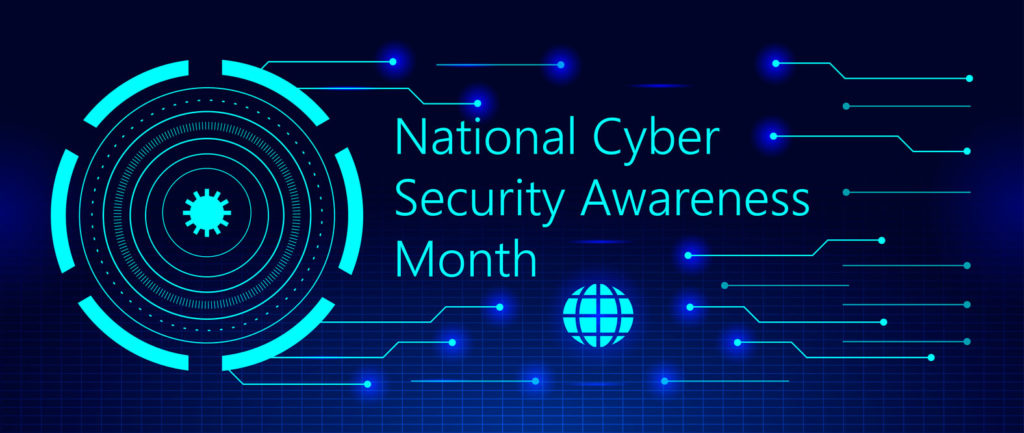
Every October, National Cybersecurity Awareness Month teaches Americans how to stay safer online. This government-sponsored initiative sheds light on security risks and best practices that can help businesses, educational institutions and consumers adopt more secure digital practices.
In this article, we’ll break down everything you should know about this year’s Cybersecurity Awareness Month, including 2020’s unique weekly themes and how to get employees on board with the movement.
What Is National Cybersecurity Awareness Month?
Did you know that 70% of Americans feel that their personal information is less secure than it was five years ago? Every October since 2004, National Cybersecurity Awareness Month (NCSAM) has been raising awareness about the resources Americans need to remain safe and secure online.
The U.S. Department of Homeland Security (DHS) and the National Cyber Security Alliance (NCSA) created National Cybersecurity Awareness Month. It is now co-led by the NCSA and CISA, the Cybersecurity and Infrastructure Security Agency.
NCSAM began by giving simple advice, like keeping antivirus software updated. It has since evolved to engage industry experts in educating their customers, employees, students and the general public on broader cybersecurity issues.
The theme for Cybersecurity Awareness Month in 2020 is “Do Your Part. #BeCyberSmart.” This theme encourages people to undertake strong security practices to protect themselves, their employers and their communities against cybersecurity threats. Educating people to take responsibility and work together in applying security standards helps make our digital lives safer for everyone.
Cybersecurity Awareness Month: 2020 Themes
NCSAM initially focused on one theme for the entire campaign month. However, in 2011, NCSA and DHS began implementing weekly themes to zero in on more specific areas in greater depth. Past themes included law enforcement, education, infrastructure, cybercrime, mobility and the needs of small and medium-sized businesses.
Here are 2020’s weekly NCSAM themes.
Theme 1: If You Connect It, Protect It
Hacking and cyberattacks are almost inevitable. Week One focuses on taking cybersecurity and its associated risks seriously. If you’re not actively taking steps to protect your digital assets and identity, you risk losing both.
- Stay up to date on patch management and the latest operating systems for computers, smartphones and network devices.
- Install antivirus software and make sure you back up your data regularly.
- Check external devices like external hard drives or thumb drives for malware and viruses.
Theme 2: Securing Devices at Home and Work
Did you know that 7-10% of Americans are victims of identity fraud each year? 21% of those victims then experience multiple incidents of identity fraud. Widespread remote work due to COVID-19 saw the rise of internet scams and phishing on a scale not experienced before. Week Two spotlights securing your devices at home and work.
- Set up two-factor (2FA) or multi-factor (MFA) authentication to identify users.
- Implement a mobile device management (MDM) policy and enforce it.
- Secure your Wi-Fi network and digital devices at home. Change default passwords and usernames following password policy guidelines.
- Use caution on social media. Never divulge personal information that would make you susceptible to hackers.
Theme 3: Securing Internet-Connected Devices in Healthcare
If your business is in the healthcare field, securing your internet-connected devices is crucial for compliance with industry standards and protecting your patients from cybercriminals. Week Three delves into security compliance for care facilities and hospitals, along with what steps you can take to protect health records, secure patient apps, improve crisis response and more.
Theme 4: The Future of Connected Devices
Week Four delves into the future of connected devices and technological innovations like 5G. Expanded data transmission can create more opportunities for cybercriminals (with less system monitoring). Therefore, it will be important to know how to adapt to such threats as technology evolves.
Tips for Implementing These Cybersecurity Themes In the Workplace
How can you successfully communicate NCAM’s ideas to your employees? Here are a few ideas:
- Email employees and stakeholders about the program, highlighting “Do Your Part. #BeCyberSmart.” Use #BeCyberSmart in emails and company communications.
- If you’re working remotely, hold a Zoom meeting to discuss each week’s theme. Solicit questions and provide guidance and practical applications.
- Host virtual security training for your company to review company practices and cybersecurity concerns, including phishing and identity theft.
- Post the Cybersecurity Awareness Month logo on your company website. Consider linking to the Cybersecurity Awareness Month “About” page to provide more info.
If you’ve ever considered partnering with a managed services provider to help implement and enforce IT security practices, look no further than Helixstorm. If you’re always putting out IT fires and feel you’re barely keeping up, we’ll help you build a solid IT foundation so you can focus on what matters — growing your organization. Plus, we bake cybersecurity into every service we offer.
When you hire Helixstorm to manage your IT, you can rest easy knowing that your security concerns are being handled for you. We solve your immediate headaches and help build your technology future.
Contact us today to learn how our managed IT services help your company #BeCyberSmart.


